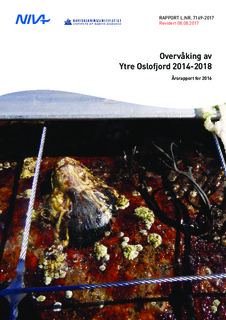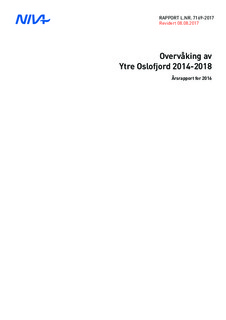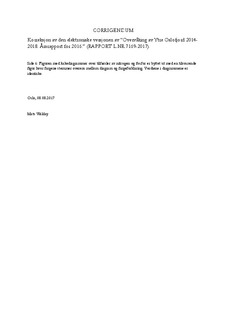| dc.contributor.author | Walday, Mats Gunnar | |
| dc.contributor.author | Gitmark, Janne Kim | |
| dc.contributor.author | Naustvoll, Lars Johan | |
| dc.contributor.author | Selvik, John Rune | |
| dc.contributor.other | Walday, Mats - Project manager | |
| dc.coverage.spatial | Oslofjorden | nb_NO |
| dc.date.accessioned | 2017-08-09T13:21:06Z | |
| dc.date.available | 2017-08-09T13:21:06Z | |
| dc.date.created | 2017-08-09T10:21:40Z | |
| dc.date.issued | 2017 | |
| dc.identifier | 7169 | |
| dc.identifier.isbn | 978-82-577-6904-8 | |
| dc.identifier.issn | 1894-7948 | |
| dc.identifier.uri | http://hdl.handle.net/11250/2450321 | |
| dc.description | Dette er en revidert versjon. Endringer er gjort på side 6, hvor figur er byttet ut med versjon med riktige farger, 08.08.2017. | nb_NO |
| dc.description.abstract | Rapporten beskriver tilførsler av nitrogen og fosfor i 2015 og resultater i 2016 for planteplankton, hydrofysikk og -kjemi samt organismer på hardbunn. Jordbruk var største enkeltkilde for menneskeskapt fosfor og nitrogen. Industriutslippene har vært nedadgående for både fosfor og nitrogen i senere år. Befolkning er en vesentlig større nitrogenkilde enn industri og viser en økning siste to år. Det er signifikant økning i tilførslene av nitrogen fra Glomma, Drammenselva og Numedalslågen. I Drammenselva og Numedalslågen også for fosfor. Glomma har de klart største tilførslene av både fosfor og nitrogen. Bunnvannet er ikke skiftet ut i sidefjordene til Oslofjorden siden vinteren 2010. Det var en moderat vannutskiftning i Iddefjorden i november 2016. Mange stasjoner hadde lik samlet tilstand i vannmassene i 2016 og 2015. For de enkelte parametere var total-fosfor generelt bedret ved en rekke stasjoner, bortsett fra på OF-2 og OF-4. Sandefjordsfjorden hadde redusert sin tilstand grunnet nitrat og oksygen., mens stasjonene i indre Hvaler viste en forbedring ift. nitrat. Sett under ett var 2016, som 2015, dominert av fureflagellater i planteplanktonet. I Hvaler har man tidligere observert markant sommeroppblomstring av kiselalger, dette var ikke tilfelle i 2016. På hardbunn var det høy forekomst av kiselalger/blågrønnalger og mye tarmgrønske i fjæresonen på stasjon G9 ved Sandefjord, G10 ved Stavern og G21 ved Hvaler. Dette er en indikasjon på næringssaltpåvirkning, men det ble ikke funnet sammenhenger mellom artssammensetningen på stasjonene og næringssalter målt i vannmassene. Registrering av nedre voksegrense hos makroalger ga «god» økologisk tilstand på seks stasjoner, «moderat» økologisk tilstand på fem stasjoner og «dårlig» økologisk tilstand på stasjon Bevøya ved Son. | nb_NO |
| dc.description.abstract | Monitoring of the water column in the outer Oslofjord is done in order to obtain information about the environment and inputs, focusing on nutrients (eutrophication). The report describes the inputs of nutrients to the fjord in 2015 and the investigations and results for phytoplankton, hydro-physical and hydro-chemical conditions and hard bottom communities in 2016. There has not been a major replacement of the bottom water in the side fjords to the Oslofjord since the winter in 2010. However, a moderate replacement in the Hvaler area was registered in November 2016, which resulted in improved conditions in the bottom water all the way to Iddefjorden. A similar replacement did not take place in the Drammensfjord and the Frierfjord. Most stations showed no changes in overall environmental conditions between 2015 and 2016. There was a reduction in the environmental conditions at the mid-fjord stations OF-2 and OF-4 due to increased total phosphate and in the Sandefjordsfjord due to increase in nitrate concentration and reduction in oxygen. In general, total phosphate conditions are improved on many stations, while stations in inner Hvaler area showed an improvement environmental condition based on the amount of nitrate. Based on salinity data, there was a lower supply of freshwater to the Oslo fjord and the side fjords in 2016 compared with previous years. This has an impact on nutrient concentrations and phytoplankton biomass in the fjord system. Generally, dinoflagellates dominated the phytoplankton in 2016. In the Hvaler area, significant summer blooms of diatoms have been observed previous years. This was not the case in 2016. Benthic investigations in Outer Oslo fjord included in 2016 surveys of hard bottom flora and fauna in the littoral zone (quantitative quadrat registrations) at 15 stations and surveys of lower growth limit for a selection of macroalgae at 12 stations. Semi-quantitative registrations of hard bottom flora and fauna in the littoral zone, financed by Borregaard AS, was conducted at 4 stations. In 2014 the introduced species pacific oyster (Crassostrea gigas) was registered at 6 station, in 2016 it was registered at 11 of the 15 “quadrat-stations” and 2 of the 12 littoral zone stations. High prevalence of diatoms- and blue-green algae and the opportunistic greenalgae, Ulva intestinalis was observedin the littoral zone at 3 stations (G9 by Sandefjord, G10 by Stavern and G21 by Hvaler) andindicateeutrophication. However, there are no obvious correlation between species composition at the stations, and nutrients measured in the surface water at nearby stations. Using the Multi Species Macroalgae Depth Index (MSMDI), 6 stations were classified to be in “good” ecological condition, 5 stations in “moderate” condition and one station (G14) was classified to be in “poor” ecological condition. | nb_NO |
| dc.description.sponsorship | Fagråd for Ytre Oslofjord | nb_NO |
| dc.language.iso | nob | nb_NO |
| dc.publisher | Norsk institutt for vannforskning | nb_NO |
| dc.relation.ispartof | NIVA-rapport | |
| dc.relation.ispartofseries | NIVA-rapport;7169 | |
| dc.rights | Navngivelse-Ikkekommersiell-DelPåSammeVilkår 4.0 Internasjonal | * |
| dc.rights.uri | http://creativecommons.org/licenses/by-nc-sa/4.0/deed.no | * |
| dc.subject | Marin | nb_NO |
| dc.subject | Marine | nb_NO |
| dc.subject | Eutrofi | nb_NO |
| dc.subject | Eutrophication | nb_NO |
| dc.subject | Overvåking | nb_NO |
| dc.subject | Monitoring | nb_NO |
| dc.subject | Miljøtilstand | nb_NO |
| dc.subject | Environmental status | nb_NO |
| dc.title | Overvåking av Ytre Oslofjord 2014-2018. Årsrapport for 2016. | nb_NO |
| dc.title.alternative | Monitoring of the outer Oslofjord. Investigations in 2016. | nb_NO |
| dc.type | Research report | nb_NO |
| dc.description.version | publishedVersion | nb_NO |
| dc.rights.holder | Norsk institutt for vannforskning / Norwegian Institute for Water Research | nb_NO |
| dc.subject.nsi | VDP::Matematikk og naturvitenskap: 400 | nb_NO |
| dc.subject.nsi | VDP::Mathematics and natural scienses: 400 | nb_NO |
| dc.source.pagenumber | 51 | nb_NO |
| dc.source.issue | 7169 | nb_NO |
| dc.identifier.cristin | 1485090 | |
| cristin.unitcode | 7464,20,11,0 | |
| cristin.unitcode | 7464,20,17,0 | |
| cristin.unitname | Marin biologi | |
| cristin.unitname | Forskningsinfrastruktur | |
| cristin.ispublished | true | |
| cristin.fulltext | original | |



